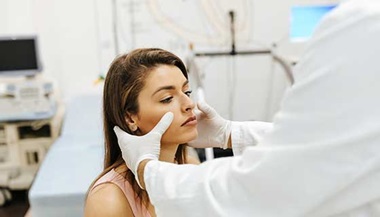Sinusitis
What is sinusitis?
Sinusitis is an infection of the lining of the sinuses near the nose. These infections most often happen after a cold or after an allergy flare-up. There are 4 types:
Acute. Symptoms last less than 4 weeks and get better with the right care.
Subacute. This type of infection does not get better with treatment at first. Symptoms last 4 to 8 weeks.
Chronic. Chronic infection happens with repeated or poorly treated acute infections. These symptoms last 8 weeks or longer.
Recurrent. If you have 3 or more episodes of acute sinusitis in a year, it’s called recurrent.
The sinuses are cavities, or air-filled pockets, that are near the nose passage. The sinuses make mucus. This fluid cleans the bacteria and other particles out of the air you breathe.
What causes sinusitis?
A sinus infection can happen after a cold. The cold inflames the nasal passages. This can block the opening of the sinuses and lead to infection. Allergies can also cause the nasal tissue to swell and make more mucus and cause sinusitis.
Other conditions that can lead to sinusitis include:
Abnormalities in the structure of the nose
Enlarged adenoids
Diving and swimming
Tooth infections
Nose injury
Foreign objects that are stuck in the nose
Secondhand smoke
If mucus drainage is blocked, bacteria may start to grow. This leads to a sinus infection, or sinusitis. The most common viruses and bacteria that cause sinusitis also cause the flu or certain kinds of pneumonia.
What are the symptoms of sinusitis?
The symptoms of sinusitis may depend on your age. These are the most common symptoms of sinusitis:
Younger children
Runny nose that lasts longer than 7 to 10 days. The discharge is often thick green or yellow, but can also be clear.
Cough at night
Occasional daytime cough
Swelling around the eyes
Older children and adults
Runny nose or cold symptoms that last longer than 7 to 10 days
Complaints of drip in the throat from the nose
Headaches
Facial pain
Bad breath
Cough
Fever
Sore throat
Swelling around the eyes, worse in the morning
The symptoms of sinusitis may look like other conditions or health problems. Always talk to your healthcare provider for a diagnosis.
How is sinusitis diagnosed?
Often, your healthcare provider can diagnosis sinusitis based on your symptoms and a physical exam. Sometimes other tests are done. These may include:
Cultures from the nose
Sinus X-rays
Sinus computed tomography (CT or CAT scan). This imaging method uses X-rays and computer technology to make images (often called slices) of the body.
Blood tests
How is sinusitis treated?
Your healthcare provider will figure out the best care based on:
How old you are
Your overall health and medical history
How sick you are
How well you can handle specific medicines, procedures, or therapies
How long the condition is expected to last
Your opinion or preference
Treatment of sinusitis may include:
Pain relievers
Nose drops
Antibiotics for severe symptoms, such as fever, face pain or tenderness, or swelling around the eyes
Surgery, if other treatments have failed
You may be referred to an allergist or immunologist, especially for chronic or recurrent sinusitis. People who have had sinus surgery, but still have sinusitis, may also be referred.
Decongestants and antihistamines do not seem to help the symptoms of sinusitis.
When should I see a healthcare provider?
You should see a healthcare provider right away if you have:
Vision changes
Severe or intense facial pain or pressure
High fever
Neck stiffness
Shortness of breath
Swelling or redness around one or both eyes
Trouble thinking
These symptoms may point to a serious condition.
Key points about sinusitis
Sinusitis is inflammation of the lining of sinuses in the face. It mainly causes pain and too much mucus production.
It may follow a cold or allergies.
Inflammation caused by a virus may resolve in about 10 days and won’t need antibiotics.
Inflammation caused by bacteria needs antibiotics.
Treatment aims to relieve the pain and discomfort, and reduce inflammation and mucus production.
Make sure to take all antibiotics as prescribed and to finish the prescription.






